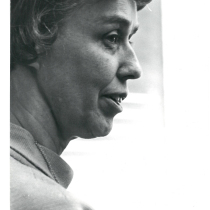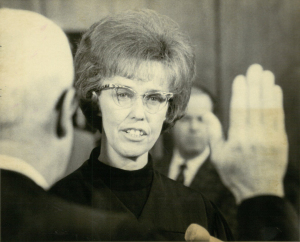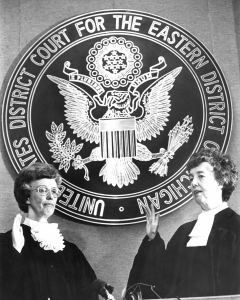Magazine

Court of Awe
The inspiring, pioneering career of Cornelia Kennedy earned her the title of “First Lady of the Michigan Judiciary.” Now, the papers of the first woman appointed to the federal bench in Michigan, and the fourth woman in the nation to be appointed a federal district court judge, have come to the Bentley, shining a light on a determined woman who knew she had to fight and work harder in her field to earn the same respect as men.
by Katie Vloet and Dan Shine
It might be the first written opinion of Cornelia Kennedy, the longtime Michigan judge who had a pioneering and distinguished judicial career. Back in May 1936, she was 15-year-old Cornelia Blanche Groefsema writing about the dangers of forest fires to her classmates in the Edison News, her Detroit school newspaper.
Kennedy discussed how early Michigan was covered in forests and the “pioneers said to themselves, ‘These forests can never be destroyed.’ But today the forest covers little of the soil of this territory,” she wrote. While on vacation in the Rocky Mountains the previous summer, Kennedy wrote about seeing a forest fire, tree trunks burning brightly at night and smoke filling the air.
“All that was left was a mass of smoldering logs,” Kennedy penned. “This can be avoided. We must stop forest fires.”
For someone who was nearly the first woman appointed to the U.S. Supreme Court and was called the “First Lady of the Michigan Judiciary,” Kennedy’s short item in her school paper as a teenager is hardly the most important or most illuminating paper in the 60-plus boxes of personal and professional items that make up her extensive collection at the Bentley Historical Library. But it does provide insight into the thoughtful girl who would become one of the most respected and groundbreaking judges in Michigan and the country.
A Novelty to Some
Born in Detroit, Kennedy and her two sisters were raised by their father, Elmer Groefsema, after their mother, Mary, died unexpectedly when Kennedy was nine.
Whether it was their mother’s death when they were young or other factors, the three sisters remained close throughout their entire lives. An August 2003 letter in the collection from her sister Margaret, days before Kennedy’s 80th birthday, shows that bond. “Dear Nealie,” her sister typed, “These passing years have made me think how special you are and how much you have done for other people all through your life, especially for me.” She wrote about how Kennedy would sit in the middle of the family car’s backseat as kids so each of her sisters could sit by a window “and not poke each other and cause a ruckus.”
“You are my dearest friend,” her sister wrote. “I feel so fortunate to be your sister.”

Kennedy being sworn in at the Detroit Federal Building in October 1970, officially becoming Michigan’s first female judge.
Kennedy inherited her love of the law from both parents; their father, a 1917 University of Michigan Law School graduate, was a distinguished Detroit trial lawyer, and their mother had been taking classes part-time at the law school prior to her death.
Their father thought all three of his daughters should go to college, and firmly believed that they should not necessarily be steered toward careers in teaching or nursing, as was the case with many educated women at the time.
All three excelled in school, as was evidenced by a letter in Kennedy’s Bentley papers from the principal of Redford High School praising the Groefsema girls.
“I know I am speaking for all of the teachers who have known your girls when I say congratulations and unstinted praise to you and the others in your family group who have helped these girls to become the fine characters that they are,” the principal wrote to Elmer Groefsema.
After attending U-M for her undergraduate degree, Kennedy went to Michigan Law and was one of fewer than 10 women in the class. After graduating in 1947, Kennedy clerked for a judge and then joined her father’s practice in Detroit. It was a time when being a female lawyer was still a novelty to some. She recalled one New York firm telling her that it hired women during the war, but “too bad for me, the war was over,” Kennedy said in a 2012 interview with the Michigan Law School’s Law Quadrangle magazine.
She never argued a case while a clerk, and remembers the early days of her law career as lonely. “Women just didn’t ask men to have lunch with them,” she said.
Her first jury trial—in Detroit’s Common Pleas Court—did draw an interested crowd, Kennedy recalled in a speech when she received the Frank Murphy Award from the Detroit Bar Association in 2011. The first draft of her acceptance speech—later typed on large index cards—was handwritten on nine notepad pages with a pale blue border and a drawing of three potted flowers on the bottom. In her talk, she recalled that first trial and how the attorney representing the other party also was a woman.
“It might have been the first jury trial tried by two women,” she told the audience that day. “The trial lasted two days and was well attended by lawyers who wanted to see two women trying a jury case.”
Another example of how women lawyers were still a novelty is Kennedy’s certificate to practice law in Washington, D.C. The clerk for the U.S. District Court for the District of Columbia typed in the information needed: the person—Cornelia Blanche Groefsema; and the date—13th day of December, 1948. But clerk Harry M. Hull could not alter the standard verbiage on the certificate that the above named was now admitted to practice as an “Attorney at Law at the Bar of this Court,” and that “he” is now “a member of said Bar in good Standing.”
Supreme Effort
Her role as one of the few female lawyers and later as one of the few female judges was a constant theme in her numerous speeches and interviews, which can be found in her Bentley archives.
At a Women Law Student Association event at U-M in 1978, Kennedy told those in attendance that to achieve the same success as a man, “women have to be more proficient than men. I am not speaking of the way things ought to be but the way they are. Well, let’s be more proficient. Let’s encourage our daughters and sisters and mothers to make that extra effort.”
Then, in pen, Kennedy added these words to the end of her remarks: “Only then will women not only be tolerated in the legal profession and the ranks of the judiciary—but welcomed.”
In a 1978 issue of the National Enquirer (yes, that National Enquirer), past the cover story on Farrah Fawcett and Lee Majors’ marital woes, a story about Patty Hearst’s romance with her bodyguard, and the mysterious disappearance of police photos of a UFO, is a feature story about Kennedy. In it, she again rallies women to “do a little more and do it better” than a man. “If someone tells me I can’t do something, my reaction is if I feel I can, I WILL do it,” she told the Enquirer.

Kennedy is sworn in as U.S. 6th Circuit Court of Appeals judge by her sister, then Farming District Judge Margaret Schaeffer, in October 1979.
Kennedy’s judicial career began with her election in 1966 to the Wayne County Circuit Court. In 1970, she was appointed to the federal bench by President Nixon, and seven years later rose to the rank of Chief Judge of the Eastern District, becoming the first woman to do so. Then, in 1979, President Carter nominated her to the U.S. Court of Appeals for the Sixth Circuit. Kennedy laughed when recounting Senator Orrin Hatch’s reaction to her during confirmation hearings: “By damn, you have a lot of qualifications,” she recalled in the Quadrangle interview.
Those qualifications put her on the short list for the U.S. Supreme Court. President Reagan narrowed his search to just two people in 1981: Kennedy and an Arizona judge named Sandra Day O’Connor, one of whom would become the first female justice.
O’Connor was chosen. “I was somewhat disappointed, but, you know, it’s a political situation. I was five years older, which was a factor, as I understand it. I quit thinking about it because there’s no purpose in it,” Kennedy told the Quadrangle.
In her papers at the Bentley, there is a copy of the note she sent O’Connor saying simply: “Congratulations and every good wish.”
Also in the collection is O’Connor’s typewritten reply thanking Kennedy. O’Connor added a handwritten post-
script: “I had always thought you would be a most excellent choice. No one was more surprised than I to receive the nomination. You have helped make it possible for a woman to be nominated by your excellent record.”
There are also letters from colleagues, friends, and everyday citizens to government officials and President Reagan advocating for Kennedy to be nominated, and then notes of support after O’Connor was chosen.
“Glad to see a woman nominated,” one colleague wrote, “but obviously Reagan got the wrong word on which woman to appoint!”
Kennedy wrote to one supporter, “I, of course, am disappointed but not dispirited.”
Circuit Court Judge Al Engel wrote to her, simply: “Dear Cornelia, You are still supreme to me.”
You Just Do It
In 2012, Kennedy hung up her robe after a 46-year judicial career. She would die two years later at age 90. In addition to the personal items in her collection at the Library, many of the cases she presided over are in her archives, along with documents from her long involvement in legal organizations, including her 27-year affiliation with the Judicial Conference of the United States, which frames policy guidelines for the administration of U.S. judicial courts.
Upon her retirement, a fellow judge wrote to her: “I join others on the court in celebrating your diligence, humor, capacity for hard work and intellect…I will miss your company and guidance more than you can imagine.”
In her typically understated way, Kennedy, with her long list of firsts, summed up her career this way to the Quadrangle: “Well, you just do it. You just go to work and do the job.”
When pressed, she added: “I guess some people have said or written that I influenced them…It’s been a great career.”
Portions of this story first appeared in the Michigan Law Quadrangle in 2012. They are reprinted here with permission.
